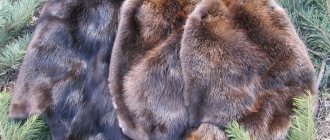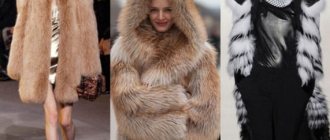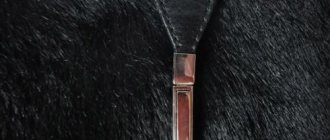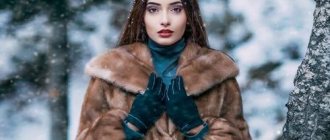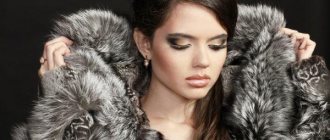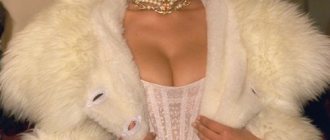Otter fur is very rare and valuable, and products made from it belong to the upper price category and are particularly elegant and luxurious. In the production of fur products, the otter is valued more than the beaver, muton or mink. This is an animal that lives in natural bodies of water and does not have a fat layer on its body. Thus, all tasks for preserving heat are assigned to the fur. An otter fur coat has excellent characteristics: it does not get wet, reliably retains heat and has a pleasant appearance.
[Show slideshow]
Benefits of an otter fur coat
- There are gradations of fur strength. The fur of an unplucked otter is taken as the standard with a score of one hundred points, as the most durable. The strength of the rest of the fur market is assessed in comparison with the standard. An otter fur coat will last longer than other options. In the old days they were passed down by inheritance; She was supposed to work for twenty to thirty seasons and leave behind good reviews.
- The otter feels confident both in water and on land. Just like the beaver, it has fur that is not afraid of moisture, does not deteriorate from water, retains its appearance, and does not become icicles in the cold.
- The otter has no subcutaneous fat. All her winter protection from the cold is contained in a fur coat. Therefore, the fibers lie close to each other, the thick undercoat is very dense. No matter how much you blow on the fur, you still won’t be able to see the inner part - the hairs fit so tightly to each other.
Where do they live?
Various species of otters are found on every continent except Australia and Antarctica. The largest number of species is distributed in such natural zones as taiga, mixed and deciduous forests, dry and humid tropical forests.
Where live
Suitable habitat for the river otter is rivers and lakes located on the plain or in the mountains with clean water and sufficient food. You are more likely to find a predator's refuge in places with rapids, whirlpools, overgrown or windfall-covered banks. Animals living in cold climate zones select habitats near areas of rivers and lakes that do not freeze in winter.
Sea otters prefer coastal areas with rocky shores and no signs of human presence.
Reliability of the manufacturer and seller
The otter is a rather rare animal in the fur industry. Her skins are even more valuable. Sales wizards can make any jerboa look like an otter. It will shine, shine in the sun, and pleasantly delight your hands with its tenderness and silkiness. The main question is how long will this miracle fur please you and who will you then file a claim with for spending money on ruining your mood.
Immediately when purchasing, you need to understand that the seller and manufacturer are responsible for the quality of the product, and you should be able to present your claims to them. You can only buy from a trusted manufacturer, for example, Levinson. Here you will never be offered models from an unknown manufacturer with a dubious reputation. Customer reviews confirm this.
Photos, descriptions and characteristics of beaver fur, differences from the Rex rabbit and care recommendations
A soft, warm, elegant fur coat is a must-have item in every woman’s wardrobe. For those who dream of luxurious and practical fur, beaver will be an excellent choice. In the old days, beaver fur was so valuable that it served as currency instead of money - the skins were used to pay for large purchases. Today, the skins of these animals are used as raw materials for sewing comfortable and beautiful fur coats, vests, and coats.
When deciding to buy a fur coat made from fur-bearing animals, it is worth learning how to determine the quality of the product by eye. The stores offer both exclusive beaver models and inexpensive analogues that differ in appearance and quality. How to recognize a fake?
Common and Canadian beaver
Only two countries in the world are engaged in mass production of beaver fur coats for the purpose of trade: Russia and Canada. Each manufacturer has its own nuances that the buyer needs to know about.
The Canadian beaver is valued higher than the common beaver. Its fur is thick, pleasant to the touch, glistens in the sun, and its wool looks expensive and luxurious. Canadian rodent fur can be found on store shelves much more often than river fur. The reason is the complex technological process of tanning hides, mass production of which is carried out only in Canada. In order for the thickness and elasticity of the skins to be the same, it is necessary to use expensive equipment and attract highly qualified specialists.
Fur quality assessment
Even with an external inspection of the fur, you can identify hidden fur defects and select high-quality products that will delight you with their quality for a long time. A few tips will help you evaluate otter fur:
- First, evaluate the external appearance of the fur coat. High-quality fur shines and shimmers in the sun, which is clearly visible in the photo. If the fur is dull, then the animal most likely lived in unfavorable conditions, and this can further deteriorate the appearance of the fur coat.
- By shaking an otter coat, you can determine the quality of the fur by ear. The fur coat should not creak or rustle when shaken.
- You should pay attention to whether the fur is dyed. The fact of painting in itself is not scary. The otter has a heterogeneous color, and to give the fur a more aesthetic appearance, the skin was tinted back in Ancient Rus'. If you blow on the fur and see the difference between the fur and the color of the fur hairs, it means the fur coat is dyed. By wiping the fur with a light cloth, information about the quality is obtained. The presence of traces of paint indicates the poor quality of the work performed.
- Good and high-quality otter skin, no matter how much you squeeze it in your fist, easily restores its shape and does not stick together. When stroking against the fur, the fur fibers should not break. The pile should not be directed in different directions.
- By wiping the pile with a woolen cloth, you can determine the quality of the workmanship. If there is lint left on the fabric, the fur coat will subsequently become covered with bald spots.
- Previously, it was believed that the lining of a good fur coat must be unfinished so that the buyer could look at the quality of the fur. For quality reasons, this requirement is not currently met; manufacturers sew the lining along the entire length.
Quality and processing of otter skins
The habitat of this animal is quite extensive; it can be found almost everywhere in Russia, with the exception of the Far North, and everywhere it is quite rare.
Sizes and colors
Along with the wolverine, it is one of the largest representatives of the mustelid family. The length of the skin with the tail can reach 2 m. The tail is very long and makes up half the length of the body, which is covered with short fur. The fur is very thick, short, and almost uniform in height over the entire area of the skin. The guard hairs are flattened, shiny and rough; in general they have the shape of a plate. This shape of the covering hair, as well as their curvature at the base, is the result of adaptation to a long stay in water.
The color of the guard hairs can range from light brown to dark brown. The down is also very thick, slightly inferior in height to the awn. The fur on the head is thicker than on the back.
In general, the color of the skins is as follows: the ridge and sides are light or dark brown, the arch, throat, chest and belly are silver with a chestnut tint.
1
The animal reaches full growth only by the third year of life, therefore the skins of animals born in the current year are very small and have high, dark brown fur, consisting of soft, delicate awns and sparse fluff. Such skins are not accepted.
Geographical variability in the river otter is weakly expressed. Its skins are divided into two ridges: northern and southern.
Southern Ridge (pelts from the Caucasus) - the fur is not so thick, more coarse. The color is generally lighter: the spine and sides are light brown, the down has a yellowish-silver color with a light brown tint.
The northern ridge (all regions except the Caucasus) - the fur is thicker and softer than that of the southern one. The color of the ridge and sides is mostly dark brown. The down is silver with a dark chestnut tint.
The area of the skin depends on the age of the animal. To determine it, measure the length from the middle between the eyes along the midline to the base of the tail and the width - we measure it in the middle part of the skin. We multiply the results obtained.
The otter, like other semi-aquatic animals, molts once during the year. Molting begins in spring and ends in winter.
More detailed otter biology is outlined in this article.
Characteristics and evaluation of fur
First grade (winter, early spring).
The fur is fully formed: tall, thick, shiny. The flesh is thin, without blue. At the beginning of spring, the fur retains all the qualities of the winter cover, it only lightens a little.
Non-standard (spring, summer, autumn).
In spring, the hair on the skins is tall, dull and lightened, noticeably thinning on the neck and scruff. In summer the hair is sparse and consists of long, faded old guard hairs and a small amount of fluff. The skin tissue is thickened. At the beginning of autumn, the old fur remains, but the growth of new hair on the rump and back is already noticeable. Closer to mid-autumn, a new coat of hair forms over the entire area of the skin; it is still low and consists of sparse, shiny undergrowth. In some places, remnants of old guard hairs remain. The mesdra is thickened and blue in color.
Second grade (late autumn).
The characteristics of fur are quite a bit inferior to winter fur. It is thick and shiny. The skin is thickened, with areas of blue.
Taking into account the peculiarity of diffuse molting in this species, it should be noted that due to the fact that in the same areas of the skin during molting there are hairs of the old and new fur, it is quite difficult to identify signs of a particular variety. Therefore, fur quality is assessed according to the following criteria: fur density and amount of old hair.
Requirements for straightening and drying
The skins must be removed in a tube, leaving the head, tail and paws without claws.
First, we make a cut from the toes of one of the hind legs to the other along the border of the hair between the sections of the womb and the rump. We cut the tail along the inside and remove the caudal vertebrae from it. The further shooting process is quite labor-intensive, because the skin is quite firmly connected to the carcass. When working, you always have to cut the connective tissue with a knife, you need to be careful not to cut the flesh. On the front paws we remove it up to the phalanges of the toes; we save the claws only if it is used to make a hunting trophy. We leave the ears and nose on the head.
When fleshing, we clean the cuts, cartilage, tendons and remaining bones in the paws and tail. By mid-autumn, the otter accumulates a good layer of subcutaneous fat, so it is worth very carefully degreasing the skin tissue.
When all the operations for cleaning the skin are completed, we proceed to editing. They should be straightened using wedge-shaped or sliding rules, maintaining a width to length ratio of 1:7.
2
You should not edit the skin too widely; with such edit, its marketability deteriorates, as it becomes sparsely haired. You need to start drying the fur with the inside out, when it starts to dry, turn it over and dry it.
3
Otter skin is very thick and durable, so defects such as tears and cuts are rare.
Usually there are the following defects:
- lumbago, - breakage of guard hairs, formed as a result of their freezing to the ice during winter fishing with traps, - draft, absence of a tail, head - the result of inept and careless handling of the skin.
Sometimes the skin is removed in a layer, poorly degreased or dried without applying the rules.
Where is fur used and its price?
Otter fur is the most durable and durable, therefore, to determine the relative quality of the fur of other fur-bearing animals, its durability is taken as 100%.
Thanks to its extraordinary density, warmth, wearability, evenness and beautiful coloring, it is highly valued, but due to its scarcity it is rarely caught by hunters. There is little fur available for rent, so few fur products are made. It is practically not used in its natural form; raw materials with plucked awns and tinted ones are usually used for tailoring.
The price of the skin of this river dweller has probably lost the most value in recent years. More recently, its cost reached 5-6 thousand rubles, now they give about 1,500 rubles for it. (season 2011/12, Kirov). Price in the 2012/2013 season. - about 2500 rub.
Plucked or unplucked otter – which one to choose?
To make otter fur soft and silky, coarse fur hairs are plucked. The fur becomes more beautiful, but its strength is lost. The men's and women's products look amazing. Reviews about otter fur coats indicate that the choice depends on the buyer’s preferences. For example, on strictly cut fur coats, unplucked otter fur looks stylish and of high quality.
Choice of style
Here are some simple tips:
- Otter fur, like jewelry, is worn for many years, as long as the owner wishes. Buying a fur coat can be considered an investment in the future. In these conditions, special attention must be paid to the choice of style. It is desirable that the style is always in fashion.
- For the classic cut of fur coats, regular or cropped fur is very suitable. Men's versions of fur coats from Levinson can be seen in the photo.
- Interesting options for combining the fur of different animals. A fur coat made of otter and beaver is stunning with its chic appearance.
- Romantic people will be pleased with fur coats made of soft plucked fur, which will envelop the owner in the form of light fluff. The price of this fur is higher, but the luxurious appearance makes these fur coats popular. The otter fur coat in the photo is striking in its appearance.
In addition to the listed unique properties, otter fur is very popular among residents of the East. The otter is considered the patron saint of representatives of water signs. It is credited with influencing health, business success and well-being.
What do they eat?
Otters are carnivorous mammals. They obtain almost all the food they consume in water. River and lake otters' diet is based on fish weighing up to 200 grams. They also eat clams, caddis flies and their larvae. In the warm months, predators hunt small amphibians and reptiles, waterfowl rodents, and small aquatic birds. The animals eat small prey directly in the water, while large fish are pulled ashore.
Sea otters feed mainly on mollusks, sea urchins, and crabs. Only in some subspecies the fish content in the diet reaches 20%. Animals hunt in shallow water. They hide all caught prey in a fold of skin under the front paw. When the fold is filled, the otter rises to the surface of the water, turns over on its back and one by one eats everything it managed to get. After each meal, the animal thoroughly washes its fur, removing any remaining food from its belly.
California sea otters use a stone to break shells and shells, which is constantly kept in one of the folds: the animal places the stone on its abdomen and methodically hits it with its prey until it breaks the protective shell.
Social structure and reproduction
Photo: Animal otter
The interaction and communication of various species of otters have their own characteristics and differences. Sea otters, for example, live in groups where both males and females are present. And the Canadian otter prefers to form groups of only male individuals, entire bachelor squads numbering from 10 to 12 animals.
Fun fact: River otters are loners. Females, together with their broods, live in the same territory, but each female tries to allocate her own separate area on it. The male’s domain includes areas of a much larger area, where he lives completely alone until the mating season begins.
Pairs are formed for a short period of mating, then the male returns to his usual free life, taking absolutely no part in communicating with his children. The breeding season usually takes place in spring and early summer. The male judges the female’s readiness for approach by her specific smelling marks left behind. The body of otters is ready for reproduction at two (in females) and three (in males) years of life. To win the lady of their heart, cavalier otters often engage in tireless fights
The female carries the cubs for two months. Up to 4 babies can be born, but usually there are only 2. The otter mother is very caring and raises her babies until they are one year old. Babies are born already in a fur coat, but they see absolutely nothing, they weigh about 100 g. After two weeks they begin to see clearly and their first attempts begin.
Closer to two months, they are already starting swimming training. During this same period, their teeth grow, which means that they begin to eat food that is typical for them. All the same, they are still too small and exposed to various dangers; even at six months they stay close to their mother. A mother teaches her offspring to fish, because their lives depend on it. Only when babies turn one year old do they become fully strengthened and adults, ready to go free swimming.
Natural enemies of the otter
Photo: River otter
Otters lead a rather secretive lifestyle, trying to settle in impassable, secluded places away from human settlements. Still, these animals have plenty of enemies.
Depending on the type of animal and the territory of its settlement, these may be:
- crocodiles;
- jaguars;
- cougars;
- wolves;
- stray dogs;
- large birds of prey;
- the Bears;
- Human.
Usually all these ill-wishers attack young and inexperienced animals. Even a fox can pose a danger to an otter, although it often turns its attention to an otter that is wounded or caught in a trap. The otter is capable of very brave defense, especially when the life of its cubs is at stake. There are cases when she entered into a fight with an alligator and came out of it with success. An angry otter is very strong, brave, dexterous and resourceful.
Still, people pose the greatest danger to otters. And the point here is not only in hunting and the pursuit of luxurious fur, but also in human activity. By massively catching fish and polluting the environment, he thereby exterminates the otter, which is in danger of extinction.
Features of character and lifestyle
Photo: Otter
The semi-aquatic lifestyle of the otter has largely shaped its life and character. The otter is very attentive and careful. She has amazing hearing, sense of smell and excellent vision. Each species of otter lives differently. The common river otter prefers an isolated lifestyle; such a mustachioed predator likes to live alone, occupying its own territory, which it successfully manages.
These animals are very active and playful, constantly swim, can walk long distances, and also hunt actively. Despite his caution, the otter has a very cheerful disposition, possessing enthusiasm and charisma. In the summer, after swimming, they are not averse to warming up their bones in the sun, catching streams of warm rays. And in winter, they are no stranger to such a common children's pastime as skiing downhill. Otters love to frolic in this way, leaving a long trail on the snow surface.
It remains from their abdomen, which they use as ice. They also ride from steep banks in the summer, loudly splashing into the water after all the fun maneuvers. While riding on such attractions, otters squeal and whistle in a funny way. There is an assumption that they do this not only for fun, but also to clean their fur coat. An abundance of fish, clean and flowing water, impassable secluded places - this is the key to a happy habitat for any otter.
If there is enough food in the otter’s chosen territory, then it can successfully live there for a long time. The animal prefers to move along the same familiar paths. The otter is not strongly tied to a specific location. If food supplies become scarcer, the animal goes on a journey to find a more suitable habitat where there will be no problems with food. In this way, the otter can travel long distances. Even on an ice crust and deep snow, it can travel 18–20 km in a day.
It is necessary to add that otters usually go hunting at night, but not always. If the otter feels completely safe, does not see any threats, then it is active and energetic almost around the clock - such a fluffy and mustachioed, endless source of vitality and energy!
